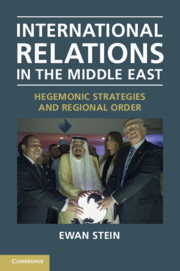Book contents
- International Relations in the Middle East
- International Relations in the Middle East
- Copyright page
- Contents
- 1 Introduction
- 2 The Order of Notables (1919–1952)
- 3 Arab Neutralism and the Cold War (1952–1967)
- 4 Towards a Middle Eastern State Conglomerate (1967–1979)
- 5 Regional Order in Khomeini’s Shadow (1979–1990)
- 6 A New Middle Eastern Order? (1990–2001)
- 7 The Middle East and the Global War on Terror (2001–2011)
- 8 Regional Order after the Arab Uprisings (2011–2020)
- 9 Conclusion
- Bibliography
- Index
2 - The Order of Notables (1919–1952)
Published online by Cambridge University Press: 28 January 2021
- International Relations in the Middle East
- International Relations in the Middle East
- Copyright page
- Contents
- 1 Introduction
- 2 The Order of Notables (1919–1952)
- 3 Arab Neutralism and the Cold War (1952–1967)
- 4 Towards a Middle Eastern State Conglomerate (1967–1979)
- 5 Regional Order in Khomeini’s Shadow (1979–1990)
- 6 A New Middle Eastern Order? (1990–2001)
- 7 The Middle East and the Global War on Terror (2001–2011)
- 8 Regional Order after the Arab Uprisings (2011–2020)
- 9 Conclusion
- Bibliography
- Index
Summary
This chapter traces the formation of Middle Eastern regional order from the end of the First World War until the Egyptian Revolution of 1952. It first analyses the role of external powers and forces in shaping the political orders and foreign policies of the Middle East’s emergent pivotal powers. The chapter then discusses the pro-Western foreign policy orientation of Turkey, a relatively ‘hegemonic’ and strategically located state. It examines the role of Arab nationalism in the hegemonic strategies of Britain’s Arab client states, before analysing the more isolationist regional policy of Saudi Arabia – which counterintuitively had much in common with Turkey during this period. The final section of the chapter discusses Iran’s seldom remarked-upon embrace of Arab nationalism during the 1940s and early 1950s.
- Type
- Chapter
- Information
- International Relations in the Middle EastHegemonic Strategies and Regional Order, pp. 33 - 53Publisher: Cambridge University PressPrint publication year: 2021



